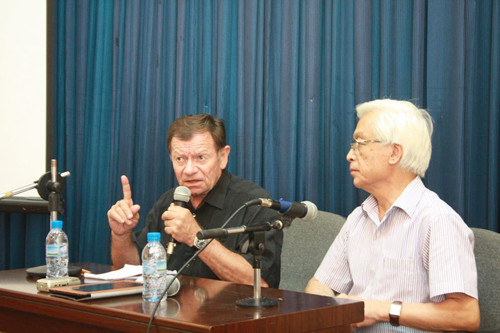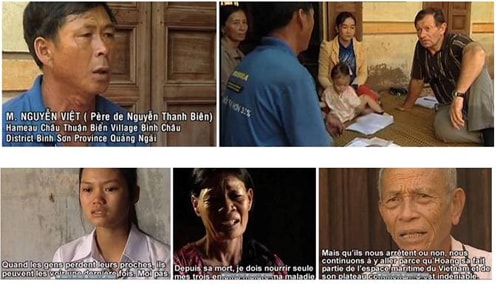Fishermen's life in 'Hoang Sa - Vietnam: The pain of loss'
André Menras - a French man who loves Vietnam made the documentary "Hoang Sa - Vietnam: The Pain of Loss". The film has just been released although it was released three years ago.
André Menras is a French native who came to Da Nang to teach French in 1968. In his anti-war spirit, André Menras and his friend Jean-Pierre Debris climbed the Marine Corps Monument in Saigon to hang the flag of the National Liberation Front of South Vietnam. For this action, André Menras and Jean-Pierre Debris were imprisoned. After his release from prison, André Menras continued to be involved in Vietnam through many practical activities. In November 2009, André Menras became a Vietnamese citizen under the name Ho Cuong Quyet.
The documentary Hoang Sa - Vietnam: The Pain of Loss was written and directed by Andre Menras - Ho Cuong Quyet. The film was completed in 2011 with the collaboration of a team from Ho Chi Minh City Television Station such as Dao Quang Tue (cameraman), Nguyen Duong Khoi (film editor), Thuy Trang (assistant director)... The film was screened on July 11 at the headquarters of the Vietnam Union of Science and Technology Associations in Hanoi.
 |
| André Menras - Ho Cuong Quyet (left) and Professor Chu Hao at the film screening on July 11 in Hanoi. |
Before filming, André Menras had to carefully study documents about the dispute in Hoang Sa and learn about the reality of the lives of fishermen in Quang Ngai. According to his statistics, from 2002 to 2011, 110 fishing boats in Hoang Sa were sunk, 500 people were arrested, and up to 20 people were killed. He also met with the arrested fishermen, listening to them talk about their days of imprisonment, hunger and thirst like miserable prisoners of war...
André Menras and the film crew went to the Quang Ngai sea to film and conduct interviews with fishermen there. The film is a mixture of images, stories, comments, and documents about the pain that fishermen in Binh Chau and Ly Son have to endure. The interviewed characters and their stories spoke of the pain of those who remained. They not only lost loved ones, but also carried a heavy debt on their shoulders. Ms. Nguyen Thi Hao, in Binh Chau, Binh Son, Quang Ngai, had a husband and children who went to sea and never returned, along with a debt of 700 million VND to pay. Ms. Le Thi Sanh could not hold back her tears when talking about her husband who went missing at sea with five others, leaving her alone with three children.
The images of wind graves in Ly Son and the spiritual rituals of worshiping those who never returned from sea at the end of the film deeply engrave the pain of loss. To build a wind grave according to custom, people have to hire a shaman, mold a mannequin to replace the deceased, put in objects symbolizing the internal organs and soul and then put it in the wind grave. Such graves without bodies line the cemetery.
André Menras also pointed out the insolent actions that China has committed against fishermen in Hoang Sa. Mr. Nguyen Van Can (An Hai, Quang Ngai) said that his father was arrested by China when he went to Bong Bay Reef in Hoang Sa archipelago to fish in 2010. In 2011, his father went to Hoang Sa and never returned. In a conversation with the filmmakers, Mr. Nguyen Viet said that his son, Nguyen Thanh Bien, was arrested by China while at sea in Hoang Sa in 2009, his boat was confiscated and his family had to pay ransom. Documents recording the ransom amount of hundreds of millions of dong in both Vietnamese and Chinese were also presented by Mr. Viet.
The film also records evidence proving that Hoang Sa belongs to Vietnam. André Menras interviewed Mr. Vo Hien Dat, an 80-year-old fisherman whose family has lived on Ly Son for generations. Mr. Dat talked about the Hoang Sa soldiers' memorial ceremony, a long-standing custom here. The filmmakers also met Mr. Pham Thoai Tuyen, a descendant of the Pham family, one of the first seven families to come to Ly Son to establish An Vinh village. Mr. Tuyen is the descendant of a military officer in the army sent by King Gia Long to Hoang Sa. In his house, Mr. Tuyen keeps more than a thousand antiques on Ly Son island such as porcelain, ancient statues, coins, Cham statues, official seals and a number of edicts in Chinese and Nom characters... Among them are books of King Gia Long praising those who went to Hoang Sa. Mr. Tuyen also presented ancient documents proving that his ancestors named two islands in Hoang Sa, Huu Nhat and Quang Anh.
 |
| Some images in the movie. |
Director Dang Nhat Minh once emailed André Menras to share: "André, I feel ashamed for not being able to make such a film." And director Tran Van Thuy said about André Menras: "His personality and the content of his films make us admire him."
When asked why a Frenchman of French origin is so interested in Vietnam, André Menras said he is grateful to Vietnam because this is where he grew up. "Coming to Vietnam as a carefree young man, I became an 'adult' here. For me, my love for France is a biological love because that is where my homeland, parents, relatives are... I love Vietnam from my heart, mind, down to my feet and have taken deep roots" - he said.
André Menras is currently in Vietnam. On July 13, he went to Quang Ngai to give the money that the audience of the film Hoang Sa - Vietnam: The Pain of Loss donated to the fishermen of Ly Son and Binh Chau. He said that he will continue to make a film in Hoang Sa in the near future. Menras revealed: "I have already written the film script, the starting point is the Haiyang 981 oil rig."
The film Hoang Sa - Vietnam: The Pain of Loss will continue to be shown in Hanoi at 8:00 p.m. on July 12 at the East-West Coffee Library (Building N11A, Lane 123 Tran Dang Ninh, Dich Vong, Cau Giay) and on August 5 at the French Cultural Exchange Institute in Ho Chi Minh City. |
According to VnExpress






